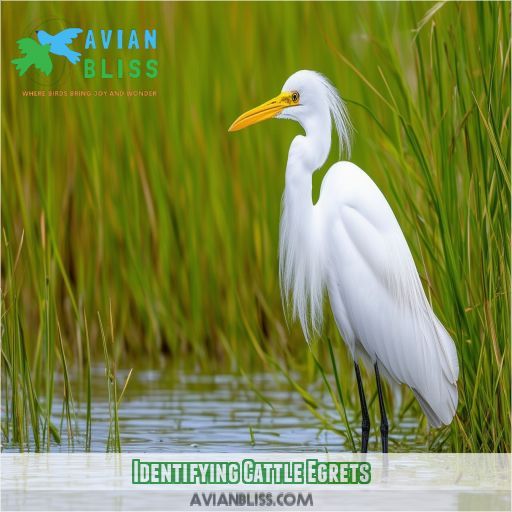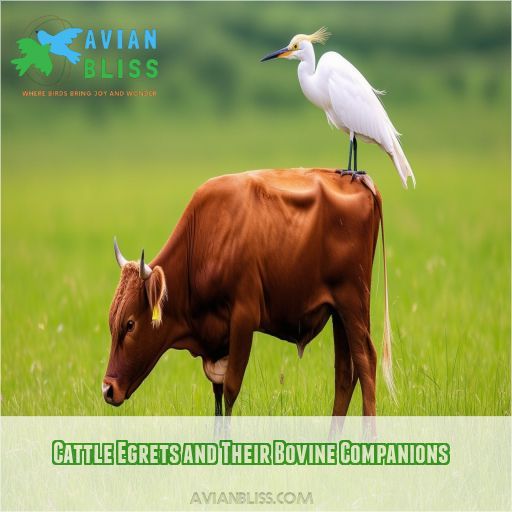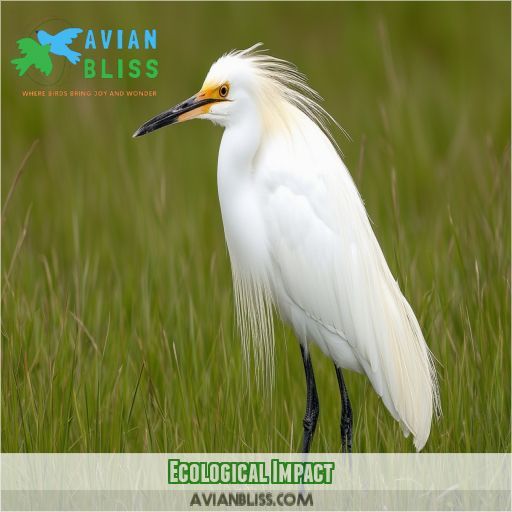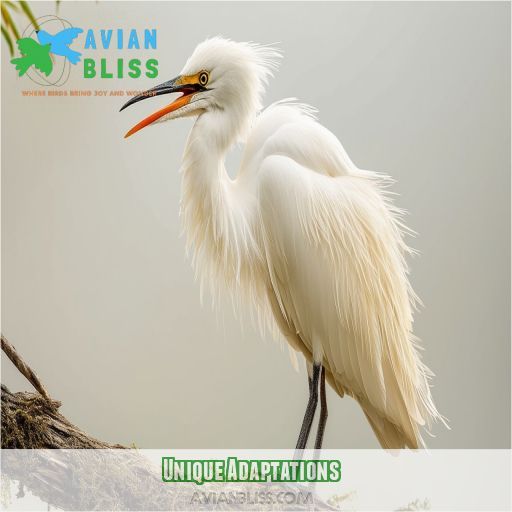This site is supported by our readers. We may earn a commission, at no cost to you, if you purchase through links.
 With a total of 4-9.85 million worldwide, the cattle egret is nature’s unsung farm hero. You will find these adaptable birds in their unique symbiosis with livestock across pastures worldwide.
With a total of 4-9.85 million worldwide, the cattle egret is nature’s unsung farm hero. You will find these adaptable birds in their unique symbiosis with livestock across pastures worldwide.
You can quickly identify them through their compact white bodies and seasonal golden plumage.
Explore their fascinating world to overview how these birds benefit agriculture, expand their distribution range, and face conservation challenges.
From intriguing specialized adaptations to cultural significance, there is much to learn about the life of the cattle egret in this journey.
Table Of Contents
- Key Takeaways
- Identifying Cattle Egrets
- Habitat and Range
- Cattle Egrets and Their Bovine Companions
- Diet and Feeding Habits
- Breeding and Nesting
- Migration Patterns
- Ecological Impact
- Conservation Status
- Unique Adaptations
- Cultural Significance
- Frequently Asked Questions (FAQs)
- Why do cattle egrets follow cows?
- How did cattle egrets get to North America?
- Is a cattle egret the same as a white egret?
- What are some interesting facts about cattle egrets?
- How fast can a cattle egret fly?
- Do cattle egrets make any distinctive vocalizations?
- What is the average lifespan of a cattle egret?
- Can cattle egrets swim or dive for food?
- Are there any notable predators of cattle egrets?
- Conclusion
Key Takeaways
- These feathered farmhands are nature’s pest control dream team, gobbling up insects stirred up by grazing livestock. Talk about a win-win situation!
- Don’t let their snowy white feathers fool you – come breeding season, these birds transform into golden-plumed beauties with legs as red as a sunburned tourist.
- Globetrotters extraordinaire, cattle egrets have gone from African savannas to worldwide sensation faster than you can say "frequent flyer miles."
- UV vision? Check. Specialized bug-crunching digestive system? You bet. These birds are like the Swiss Army knives of the avian world, adapting to whatever Mother Nature throws their way.
Identifying Cattle Egrets
You’ll find that identifying cattle egrets is easiest during breeding season when their plumage changes dramatically. Their normally white feathers develop golden patches on the head, breast, and back, while their legs and bill transform from yellow to a striking bright red at peak breeding time.
Physical Characteristics
You’ll spot a cattle egret by its compact, stocky build and thick neck. These white herons stand out with their sturdy, yellow bills and distinctive posture. Here are three key features to look for:
- Flight behavior: Neck tucked in while flying
- Leg color variation: Yellow, red, or black depending on age and season
- Nonbreeding plumage: Entirely white with black legs and short yellow bill
Juveniles sport black bills and legs, making them easy to distinguish from adults in their crisp white plumage.
Seasonal Plumage Changes
You’ll notice striking changes in cattle egrets throughout the year.
During breeding season, they’re a sight to behold with golden feathers adorning their head, breast, and back. At peak breeding, their legs and bill turn bright red.
Come winter, they’re pure white with black legs.
Juveniles sport an all-white plumage with black legs and bill.
These seasonal transformations help you identify these farm-friendly birds in any season.
Habitat and Range
You’ll find that cattle egrets have expanded far beyond their native African grasslands. These adaptable birds now inhabit a wide range of open habitats across the Americas, Europe, Asia, and Australasia, thriving in both natural and agricultural landscapes.
Native Regions
Native areas for cattle egrets include sub-Saharan Africa and parts of South Asia. These birds frequent grasslands, savannas, and wetlands and are adaptable in their habitats. There’s always been evolution together with large herbivores, specializing in specific relationships with grazing animals. Here is why their native habitats are crucial:
- Provide essential breeding grounds
- Maintain diverse prey populations
- Natural protection to predators
- Ecological Balance Maintenance in Grazing Ecosystems
Knowing their origins helps conservation efforts and gives meaning to their remarkable migration patterns.
Global Distribution
You’ll find Cattle Egrets far beyond their African origins. These adaptable birds have hitched a ride with global cattle farming, expanding their range to every continent except Antarctica.
They’ve become invasive species in some areas, impacting local ecosystems. Their distribution is closely tied to agricultural landscapes, and climate change may further alter their global presence.
Keep an eye out for these white-feathered farm helpers worldwide!
Cattle Egrets and Their Bovine Companions
You’ll often spot cattle egrets following closely behind grazing cows, forming a fascinating symbiotic relationship. These opportunistic birds take advantage of the insects and small animals stirred up by the cattle’s movements, showcasing their unique foraging behavior as they snatch up prey flushed from the grass.
Symbiotic Relationship
You’ve likely seen cattle egrets perched atop cows in pastures, but did you know they’re nature’s farm helpers? These clever birds have formed a fascinating symbiotic relationship with grazing animals.
As cattle move through fields, they stir up insects, creating a buffet for the egrets. In return, the birds rid cattle of pesky parasites, making this partnership a win-win for both species.
Foraging Behavior
You will often see cattle egrets using astute foraging strategies associated with grazing mammals. In other words, these clever birds congregate around cattle, horses, or sheep and take advantage of the insects flushed out from their hiding places due to hooves.
With incredible reflexes, they catch flies, grasshoppers, and other such types of food by following behind these bovine companions.
Such feeding behavior has two advantages at once: it feeds the egrets but is also in the service of pest control for farmers.
Diet and Feeding Habits
You’ll find that cattle egrets have a strong preference for insects, particularly grasshoppers, crickets, and flies, which make up the bulk of their diet. These opportunistic feeders also consume small vertebrates like frogs and birds, adapting their feeding habits to take advantage of available food sources in their environment.
Insect Preferences
You’ll find cattle egrets have a strong preference for insects, making them nature’s farm helpers on a global scale. Their diet primarily consists of grasshoppers, crickets, and flies, which they expertly snatch from the ground.
These birds have adapted their foraging strategy to take advantage of insect abundance in agricultural settings.
Their prey selection isn’t random; they’re skilled at targeting the most prevalent and nutritious insects in their environment.
Opportunistic Feeding
You will find the cattle egrets to be masterly opportunistic feeders. They’ve developed associations with grazing animals and take full advantage of the insects disturbed by their feet. In accomplishing this, the birds enhance the success of their foraging double-fold while decreasing the insect burden from the environment.
They aren’t particularly fastidious, and when the chance does come their way, they do eat small vertebrates or even other birds.
Their habitat selection thus often focuses on these feeding possibilities.
Breeding and Nesting
Cattle egrets form breeding colonies, often joining existing heron and egret nesting sites. They typically lay 3-4 eggs, which both parents incubate for 21-26 days before the chicks hatch and begin their journey to independence.
Colony Formation
You’ll find cattle egrets nesting in bustling colonies, often joining forces with other heron species. These social birds establish a clear pecking order and engage in elaborate communication rituals. Here’s a glimpse into their colony formation:
- Nest location: Trees or shrubs near water bodies
- Colony size: Can range from dozens to thousands of pairs
- Breeding plumage: Golden feathers appear on head, breast, and back
- Territory defense: Males fiercely guard their chosen nesting spots
Egg Laying and Incubation
You’ll find cattle egrets laying 3-4 eggs in a clutch, though it can range from 1-9. Both parents share incubation duties for 21-26 days.
Once hatched, the nestlings are fed by regurgitation from both mom and dad.
At 15-20 days, the young adventurers start exploring near the nest. They’ll take their first flight at 25-30 days and become independent little egrets around 45 days old.
Migration Patterns
You’ll find that cattle egrets exhibit fascinating migration patterns, with some populations undertaking seasonal movements while others remain relatively sedentary. Their remarkable range expansion from Africa to other continents has been one of the most rapid and widespread of any bird species in recorded history.
Seasonal Movements
You’ll find cattle egrets adapting their movements to seasonal changes. They’re not strictly migratory, but they’ll shift their range as food availability fluctuates.
In North America, they often move northward during spring and summer, then retreat south as temperatures drop.
Climate change is altering these patterns, with some populations staying year-round in areas that were once only summer habitats.
Their flexibility helps them thrive in changing environments.
Range Expansion
You’ll be amazed by the Cattle Egret‘s impressive range expansion. Originally found in sub-Saharan Africa, these adaptable birds have spread their wings across the globe. They’ve hitched a ride on the coattails of cattle ranching, expanding into new territories.
While this expansion showcases their resilience, it’s not without controversy. Some areas view them as invasive species, potentially impacting local ecosystems.
Climate change and agricultural practices continue to shape their expanding footprint.
Ecological Impact
Cattle egrets offer significant benefits to agriculture by consuming insect pests that damage crops and livestock, potentially reducing the need for chemical pesticides. However, their rapid global expansion has raised concerns about competition with native bird species for nesting sites and food resources, particularly in areas where they’ve been introduced.
Benefits to Agriculture
As cattle egrets follow migrating herds, you’ll notice their significant impact on agriculture. These birds form symbiotic relationships with livestock, consuming insects that pester cattle. Their presence can reduce pest populations, potentially saving farmers money on pesticides.
However, their economic impact isn’t just positive; in some areas, they’re considered invasive species.
Despite this, many cultures revere these adaptable birds for their role in pest control and their ability to thrive alongside human activity.
Competition With Native Species
As cattle egrets expand their global reach, you’ll find they’re not always welcomed by native species. These adaptable birds can outcompete local avians for resources, leading to territorial disputes and population shifts. Their aggressive defense of nesting sites often displaces natives, altering local ecosystems.
- Cattle egrets may reduce nesting success of native herons
- They can monopolize prime feeding areas, forcing out local birds
- Their rapid population growth can upset existing avian community dynamics
Conservation Status
Despite their widespread distribution and adaptability, cattle egret populations are carefully monitored for potential impacts of climate change. You’ll find that while their overall numbers remain stable, shifts in habitat availability and extreme weather events could affect their long-term conservation status.
Population Trends
You’ll be amazed by the cattle egret’s population dynamics. These farm-friendly birds have experienced explosive growth since the 1940s, with their range expanding across continents.
In just decades, they’ve colonized new territories from Australia to Europe and India. The nominate western subspecies has shown remarkable adaptability, leading to high population densities in some areas.
However, recent studies suggest their growth may be slowing in certain regions.
Climate Change Effects
Climate change is redefining the world of Cattle Egrets. Their ranges will undoubtedly be seen for what they’re as these birds get accustomed to the new conditions. On account of the rising temperature, these versatile birds are moving ever further northwards in search of cooler climes. But all isn’t plain sailing:
- Coastal wetlands lost to sea level rise
- Droughts turning lush fields into barren landscapes
• Extreme weather events destroying nesting sites
- Insects Vanishing, Leaving Egrets Scrambling for Food
- Native species facing increased competition as habitats shrink
Unique Adaptations
You’ll be fascinated to learn that cattle egrets have developed a specialized digestive system that allows them to efficiently process the tough exoskeletons of insects they consume. Additionally, these remarkable birds possess UV light vision, which helps them detect insects and other prey more easily in grassy fields, giving them a distinct advantage in their foraging activities.
Specialized Digestive System
You’ll be fascinated to learn about the cattle egret’s specialized digestive system. These birds have evolved unique adaptations to process their insect-heavy diet efficiently. Their digestive tract modifications and enzyme secretion variations set them apart from other species.
| Adaptation | Function |
|---|---|
| Short bill | Quick insect capture |
| Large crop | Temporary food storage |
| Unique enzymes | Efficient protein breakdown |
| Modified stomach | Rapid digestion of chitinous exoskeletons |
These adaptations allow cattle egrets to thrive in their agricultural habitats, making them nature’s perfect farm helpers.
UV Light Vision
As if their specialized digestive system wasn’t impressive enough, cattle egrets have another trick up their sleeve: UV light vision.
This unique adaptation allows them to detect prey and avoid predators more effectively, especially during low-light conditions.
You’ll find that these birds can spot UV-reflective urine trails left by small animals, giving them an edge in hunting strategies.
It’s like they’re wearing nature’s night-vision goggles, making them even more efficient farm helpers around the clock.
Cultural Significance
You’ll find that cattle egrets have captured the imagination of various cultures, appearing in folklore and literature across their range. These birds often symbolize harmony between humans and nature, reflecting their close association with farmers and livestock in many societies.
Symbolism in Different Cultures
You’ll find cattle egrets symbolize different things across cultures, especially in regions where they’re common. These adaptable birds have made their mark on human societies:
- North America: Symbol of agricultural prosperity
- East Asia: Harbinger of good fortune in rice farming
- Africa: Representation of harmony between wildlife and livestock
- India: Sacred animal, often associated with cattle ranching
Their presence near dairy farms and grazing lands has cemented their cultural significance in many parts of the world.
Role in Folklore and Literature
You’ll find cattle egrets weaving their way into folklore and literature, reflecting their unique relationship with humans and livestock. These white herons, with African origins, have captured imaginations worldwide. Here’s a glimpse of their cultural impact:
| Region | Folklore | Literature |
|---|---|---|
| Africa | Symbol of harmony | Featured in proverbs |
| India | Associated with cattle gods | Appears in poetry |
| Americas | Represents adaptability | Metaphor for migration |
| Australia | Embodies resilience | Depicted in children’s books |
Their journey from marginally larger birds in Africa to bright red-legged icons in North America showcases their symbiotic relationships with humans and nature.
Frequently Asked Questions (FAQs)
Why do cattle egrets follow cows?
You’ll often see cattle egrets trailing cows, taking advantage of a clever feeding strategy. As the cows move, they stir up insects from the grass. This provides an easy meal for the opportunistic birds, who snatch up the flushed prey.
How did cattle egrets get to North America?
Picture a feathered globetrotter soaring across vast oceans. You’ll find cattle egrets hitchhiked their way to North America, arriving in They’re not native but expanded from Africa, crossing the Atlantic and settling in the U.S. by
Is a cattle egret the same as a white egret?
No, they’re not the same. White egrets are a group of birds, while cattle egrets are a specific species. You’ll notice cattle egrets are smaller, with a yellow bill and unique breeding plumage. They’re often found near grazing animals.
What are some interesting facts about cattle egrets?
You might think they’re just white birds, but there’s more to the story. Cattle egrets are globe-trotting opportunists, hitching rides on livestock to snag insects. They’ve even been known to catch a lift on moving vehicles!
How fast can a cattle egret fly?
You’d be surprised by a cattle egret’s speed! While exact figures aren’t well-documented, these compact birds can likely reach speeds of 20-30 mph during flight. They’re built for efficiency, not racing, but they’re no slouches either.
Do cattle egrets make any distinctive vocalizations?
You’d think these birds would moo, but no! Cattle egrets actually make harsh, guttural croaks and squawks. They’re not known for melodious songs, but rather for their raucous calls during breeding season or when disturbed.
What is the average lifespan of a cattle egret?
You’ll find that most wild birds live shorter lives than their captive counterparts. In the wild, you’re looking at about 5-15 years for many species, depending on factors like predation, disease, and environmental conditions.
Can cattle egrets swim or dive for food?
You won’t see cattle egrets swimming or diving for food. They’re ground foragers, preferring dry fields and pastures. These birds stick close to grazing animals, snatching up insects and small creatures stirred up by their hooves.
Are there any notable predators of cattle egrets?
You’d think predators would steer clear of these feathered friends, but they’ve got quite a fan club. Hawks, eagles, and owls often swoop in for a taste. Even alligators and snakes join the party in wetland areas.
Conclusion
Well, you now know the cattle egret is an amazing feathered friend in farming. Such a versatile bird with a unique symbiotic relationship between them and various kinds of livestock also proves very important in regulating pests and balancing ecosystems.
You have learned about their characteristics, global distribution, and intriguing behaviors. From UV vision to cultural significance, the stocky heron is still something researchers and nature lovers alike are interested in learning more about.
Considering their conservation challenges, be reminded that ensuring these unsung heroes of the farm are protected serves to maintain a sensitive ecological balance for the betterment of both wildlife and human agriculture.













